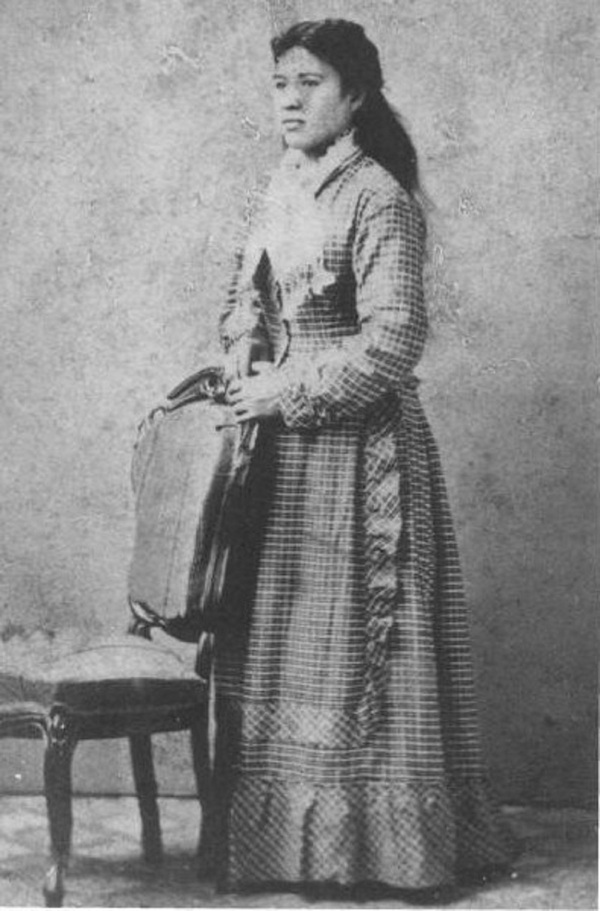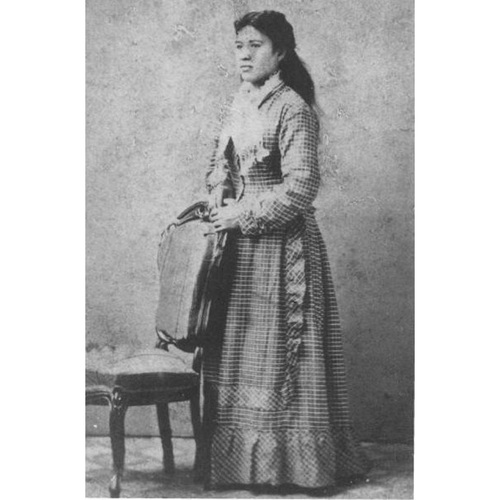
Source: Courtesy of Wikimedia Commons
Mahoi (Mahoy, Magoi), Maria (Douglas; Fisher), homemaker and midwife; b. c. 1855 on southern Vancouver Island; about 1870 she entered into a common-law relationship with Abel Douglas (Douglass) (d. 25 Nov. 1908), and they had four daughters and three sons; in the mid 1880s she entered into a common-law relationship with George Fisher (d. 28 March 1948), whom she married 9 Jan. 1900, and they had four daughters and two sons; d. 1 July 1936 on Russell Island, B.C.
Maria Mahoi exemplifies those usually left out of history, in part because few records of their lives have survived, and in part because they had no achievements measured by usual standards. During her lifetime no one considered her important enough to interview, nor did anyone write about her. Indigenous and illiterate, she had a difficult existence. While the outlines of her life can be pieced together from such impersonal sources as manuscript censuses and vital statistics, it is her descendants’ recollections that make it possible to retrieve the contributions she made to Canadian society.
Maria’s father was one of several hundred native Hawaiians recruited into the northwest fur trade during the early and mid 19th century by the Pacific Fur Company, the North West Company, and later the Hudson’s Bay Company. Hawaiians of the period used a single name, and a man known as Mahoi was employed at Fort Victoria (Victoria) about the time of Maria’s birth to a local Indigenous woman. All her life Maria would identify more with her Hawaiian than her Indigenous heritage. She took pride in her surname, so much so that contemporaries generally used it to refer to her despite the two men in her life.
Surviving photos depict Maria as darkly attractive in youth, trimly dressed in middle age, and still vital as an old woman. The earliest was taken sometime after she began to cohabit at age 15 with Abel Douglas, a sea captain originally from Maine. They lived in Victoria, where businessmen hoping to establish a whaling industry had enticed Abel north from California in 1868. The venture was short-lived, however, owing to the fall in the price of whale oil, which was being replaced by petroleum. Abel stayed on, likely because of Maria. He fished, traded, and would later go sealing. Their first child, George, born in 1871, would be followed by six more children.
Sometime in the mid 1870s Maria and Abel settled on southern Salt Spring Island, one of the Gulf Islands in the Strait of Georgia. The impetus for the move was likely hers, for over a dozen Hawaiians, including William Naukana*, lived there or on small islands nearby with their Indigenous wives and families. Maria’s relationship with Abel disintegrated in the mid 1880s, whereupon she began living with George Fisher, a well-educated man of mixed race who farmed nearby. Maria and George were formally married on 9 Jan. 1900, shortly after he had a life-threatening accident. George, a devout Roman Catholic, may have wanted to legitimize his children and to ensure that he did not die in sin.
Two years later Maria produced affidavits in court claiming that she was entitled to the estate of a recently deceased Hawaiian neighbour, William Haumea, since she was the daughter, Mary Ann Haumea, mentioned in his will. It has not been possible to determine the accuracy of these claims, but the judge was satisfied and awarded her ownership of nearby Russell Island. Maria and George transformed the 40-acre island into a base where their family could be largely self-supporting. In addition to tending the orchard and garden, family members hunted and fished, and sold clams, berries, fish, and seaweed.
Maria’s determination to provide for each of her children as best she could led her to send two of the daughters she had with Abel Douglas to a Catholic boarding school for mixed-race girls (including non-Indigenous pupils) operated by the Sisters of St Ann at Duncan on Vancouver Island. Her other children she shepherded through illness and watched over throughout their adult lives. All except one child would survive to adulthood, but five would predecease her.
Although there was widespread racial prejudice against persons perceived to be of mixed race, the scarcity of non-Indigenous women in British Columbia meant that Maria’s daughters could, if they wanted, find white husbands and meld into the edges of the dominant society. Her sons had no such choice and, whether single or married to mixed-race persons like themselves, they opted to settle near Maria.
Ordinary women like Maria built community. A skilled midwife, she received what families could spare in exchange for her services. According to family recollections, “Everyone sent for her in those days.” She would “just drop everything and go, all over Salt Spring.” Among the many babies she delivered were those of leading families and William Naukana’s grandchildren. Sociability was central to Maria’s home. Passers-by, whether they were neighbours from the Gulf Islands or Indigenous people travelling along the coast, were assured of a warm welcome.
Maria Mahoi’s legacy survives into the 21st century. Her descendants span the range of British Columbians from fishers and loggers to businesspeople and provincial politicians such as Mel Couvelier. Her property, Russell Island, continues much as it was in Maria’s time, but is now part of the Gulf Islands National Park Reserve, created in 2003.
This biography is based on the author’s work Maria Mahoi of the islands (Vancouver, 2004), which contains a complete list of sources that have been consulted. They include conversations with descendants of Maria Mahoi, parish and school registers, censuses, vital statistics, and land records. Additional information can be found in Tom Koppel, Kanaka: the untold story of Hawaiian pioneers in British Columbia and the Pacific northwest (Vancouver, 1995).
Cite This Article
Jean Barman, “MAHOI (Mahoy, Magoi), MARIA (Douglas; Fisher),” in Dictionary of Canadian Biography, vol. 16, University of Toronto/Université Laval, 2003–, accessed December 12, 2025, https://www.biographi.ca/en/bio/mahoi_maria_16E.html.
The citation above shows the format for footnotes and endnotes according to the Chicago manual of style (16th edition). Information to be used in other citation formats:
| Permalink: | https://www.biographi.ca/en/bio/mahoi_maria_16E.html |
| Author of Article: | Jean Barman |
| Title of Article: | MAHOI (Mahoy, Magoi), MARIA (Douglas; Fisher) |
| Publication Name: | Dictionary of Canadian Biography, vol. 16 |
| Publisher: | University of Toronto/Université Laval |
| Year of publication: | 2015 |
| Year of revision: | 2023 |
| Access Date: | December 12, 2025 |



